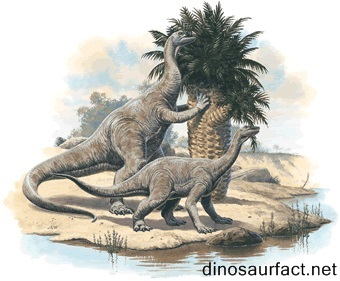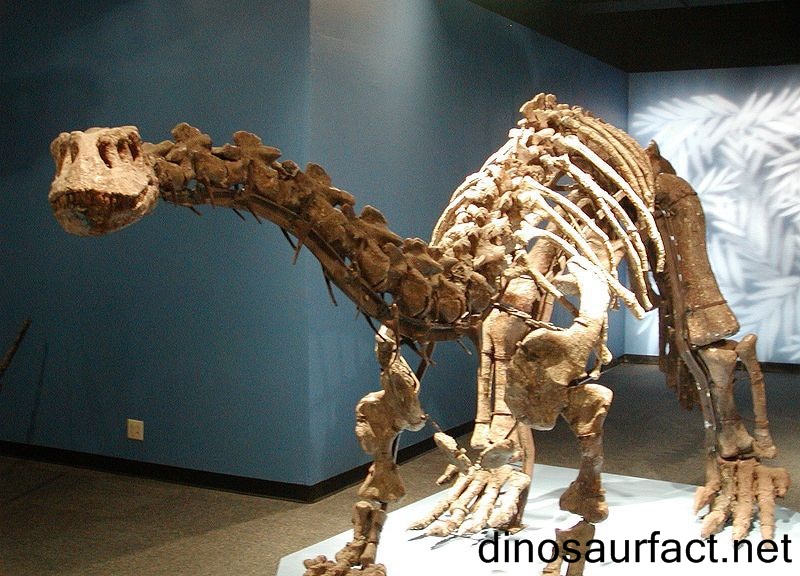 Click to visit the previous dinosaur bio
Click to visit the previous dinosaur bio
 |
|
 |
|
Kingdom: Animalia
Phylum: Chordata
Class: Sauropsida
Superorder: Dinosauria
Order: Saurischia
Suborder: Sauropodomorpha
Family: Melanorosauridae
Genus: Lessemsaurus
 |
|
 |
|
 |
|

The Lessemsaurus was a dinosaur which existed in the late Triassic period. It was present on the earth about 213 to 205 million years ago. This time period lies right at the border of the Triassic and Jurassic period, in the Norian and Rhaetian ages. It is also possible that this dinosaur survived the Triassic- Jurassic extinction event.
The remains of the Lessemsaurus were found in Argentina. Thus it is possible it could have inhabited the whole of the South American continent along with Africa. Africa and South America was a supercontinent, ‘Gondwana’ in the Triassic period.
The Lessemsaurus is believed to be an early sauropodomorph. These dinosaurs were slowing moving, quadrupeds and herbivorous. Their diet consisted of plants, leaves, shrubs and grasses. The classification of the Lessemsaurus does not have universal consensus. The reason for this is the incomplete nature of its fossils. Some scientists believe that it could have been a melanosaurid. This would make it slightly more evolved than a primitive sauropod.
The Lessemsaurus was a fairly large creature. Adult specimens could grow to the lengths of 9 to 10 meters. They would weigh about 3000 to 4000 kilos. Although this size seems substantial, the largest sauropods could achieve weights 10 times as much as the Lessemsaurus.
Etymology
The Lessemsaurus is named after the American author and dinosaur enthusiast Don Lessem.
The suffix ‘-saurus’ is derived from the Greek word ‘sauros’ which means ‘lizard’ in English. Thus, the name ‘Lessemsaurus’ roughly translates to ‘lizard of Lessem.
The binomial name Lessemsaurus sauropoides is selected based on the lineage of the dinosaur.
The fossils of the Lessemsaurus were christened by scientist Jose Fernando Bonaparte.
Discovery of fossils
The remains of the Lessemsaurus were found in the La Rioja province of Argentina in South America. They were discovered in the Los Colorados Formation which is located in the western region of Argentina.
The fossils were brought to the attention of Bonaparte in 1998 and he defined them in the year 1999.
The bones of the Lessemsaurus were found in the same vicinity as those of the more famous Argentinian dinosaur, the Riojasaurus.
Nature of fossils
- A few vertebrae and some long bones of the extremities represent the fossils of the Lessemsaurus. Thus, its museum displays are based on extrapolations made from other sauropods and the aesthetics of the artist creating the exhibits.
- The vertebrae possessed prominent articular and neural processes. These features were more exaggerated in the better evolved sauropods and hence Bonaparte believed that it was a primitive member of the sauropod group.
- In the year 2007, scientists Powell and Pol describe the limbs and the shoulder and pelvic girdle of the Lessemsaurus. They noticed that these bones showed a transitional nature between basal sauropods and prosauropods. The scapula had features which resembled prosauropods, while the humerus and femur better matched early sauropodomorphs.
This has made it even more difficult for paleontologist to place in in the evolutionary chart.
Classification
A complete skeleton of the Lessemsaurus has never been found yet. And, as mentioned above, its currently available bones have intermediate features. Thus, its classification is a matter of debate.
But despite of this, the higher classification of the Lessemsaurus is clear. It belongs to suborder Sauropodomorpha and infraorder Sauropoda.
The placement of the Lessemsaurus in family Melanosauridae is questionable and is not universally accepted.
Only one species is ascribed to genus Lessemsaurus, the L. sauropoides.
Jose Bonaparte
- Jose Fernando Bonaparte is a veteran Argentinian geologist. He is primarily interested in mammalian fossils.
- Bonaparte was born in the town of Rosario to Italian parents. His father was a sailor and hence he was exploring the coastlines of Argentina since a very young age. In fact this was when he began his fossils collection.
- He is a traditionalist and shuns many of the modern methods of cladistics. This can be attributed to the fact that he never formally studied paleontology and had his own unique approach towards studying fossils.
- But the lack of a formal education did not hamper his work. He has turned Argentina into a hub for paleontology and geology by the merit of his efforts.
The Los Colorado Formation
The Los Colorado Formation is a natural stratified rock formation present in the La Rioja district of Argentina. The fossils in this region date back to boundary of the Triassic and Jurassic periods of the Mesozoic era. It is one of the most important geological structures of South America.
The thickness of this formation is about 600 meters. Its layers are reddish to brown in color and are composed of sandstone.
The Los Colorados Formation overlies the Ischigaulasto Formation.
Physical features
- It is believed that the Lessemsaurus could achieve a size close to 30 feet. Is mass is estimated to be about 3 to 4 tons.
- The Lessemsaurus probably possessed a blunt cervical crest based of the morphology of its vertebrae.
- Its neck was long and slender.
- No skull has been ascribed to the Lessemsaurus and hence the dimensions of its head cannot be determined.
- The legs of the Lessemsaurus were stout like other sauropods.
Habits and habitat
The Lessemsaurus walked on all four legs. This was an adaptation that permitted sauropods to attain their gargantuan sizes.
It was an herbivorous dinosaur. Although its teeth have not yet been discovered, its feeding habits can be judged based of the fact that it was large sauropod.
The habitat of the Lessemsaurus consisted of wooded areas which had small water bodies such as lakes and ponds.
Related and coexisting species
Although it is not certain whether the Lessemsaurus itself was a melanosaurid, it was definitely related to the members of this group like the Melanosaurus.
Fossils of dinosaurs such as the Coloradisaurus, Riojasaurus and the Zupaysaurus were found in the same formation as the Lessemsaurus and hence it is very likely that they shared the same environment.
Epilogue
The Lessemsaurus is not very well defined. Its fossils are limited in number, with its skull being conspicuously missing. Due to this, most of the information gathered about it stems from judgment and guesswork.
But this does not mar its importance. The Lessemsaurus has helped paleontologist understand the stages evolution that led to the development of the gigantic sauropods of the Jurassic and Cretaceous periods.
Index
Extinct Profiles
 Triassic Dinosaurs
Triassic Dinosaurs Jurassic Dinosaurs
Jurassic Dinosaurs Cretaceous Dinosaurs
Cretaceous Dinosaurs Pterosaurs
Pterosaurs Marine Reptiles
Marine Reptiles Dinosaur Extinction
Dinosaur Extinction